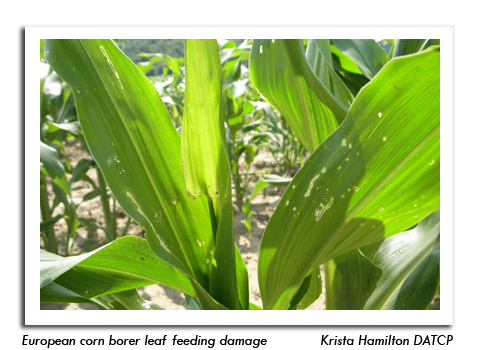
 |
|
|
Corn
Volume 57 Number 12 Date 06/28/2012 EUROPEAN CORN BORER - Larvae from the spring flight of moths are generally in the intermediate to late development stages and evidence of their feeding was observed in a few fields this week. Examination of grain corn in the south-central, southwest and central districts found second- to fifth-instar larvae in 16% of surveyed fields. Leaf feeding was apparent on a maximum of 24% of plants and no economic populations were noted. WESTERN BEAN CUTWORM - The first significant captures of 36-92 moths were registered at Sparta and Wautoma in the past week. Peak flight (50% emergence of the population) should occur around 1,422 degree days, or from July 1-15 at most sites. Degree day accumulations (base 50°F) as of June 27 were 1,421 at Beloit, 1,344 at Madison, 1,201 at Hancock and 1,142 at Appleton. Oviposition on corn and dry beans has been underway for two weeks and is intensifying. Corn fields in Columbia and Sauk counties are showing eggs and small larvae. Treatment may be required for field corn with infestations affecting 5% of the plants at 90-95% tassel emergence. The economic threshold is 4% for processing sweet corn. YELLOWSTRIPED ARMYWORM - Light injury attributed to this insect was found in scattered fields in Columbia, Dodge, Sauk and Vernon counties. Approximately 2-14% of the plants showed ragged leaves with defoliation occurring from leaf edge toward the midrib, similar to the pattern of feeding caused by true armyworm. According to the Entomological Society of America's (ESA) Handbook of Corn Insects, "Control [of the yellowstriped armyworm] with insecticides is not economical unless feeding causes heavy damage (defoliation greater than 50%)." VARIEGATED CUTWORM - Larval infestations have subsided due to pupation and chemical treatment of many fields, but there is a remote possibility for new infestations and isolated areas requiring treatment in the next few days. Continued scouting is recommended for corn, alfalfa and soybeans in the far northern counties. CORN EARWORM - Southerly winds to the east of a cold front directed a few moths into the state from southern source regions. The pheromone traps near Ripon in Fond du Lac County registered counts of 35-41 moths from June 21-27. With field corn tasseling rates increasing across the state and sweet corn fields already at critical stages, growers should continue to monitor fields for isolated moth flights. A low migration risk is predicted for the next five days. --Krista Hamilton, DATCP Entomologist 





|
|
|